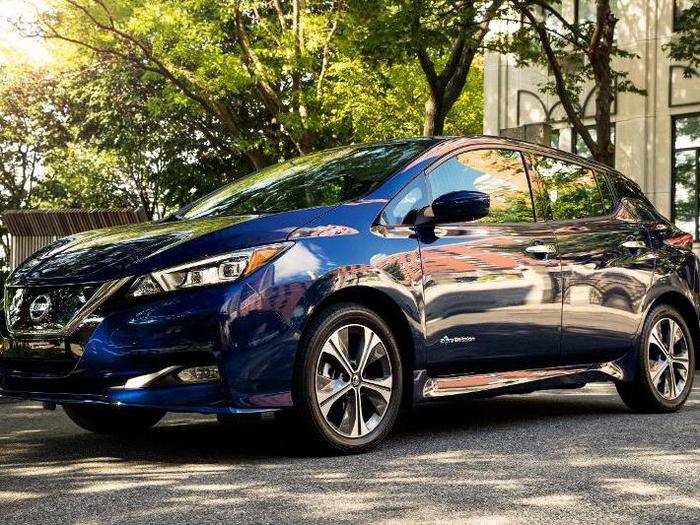










The Leaf has regenerative braking. And when the e-Pedal feature is engaged, it's possible to drive the car using motor braking almost alone, putting power back into the battery.
We used the ChargePoint network and did fine with two rounds of 240V charging over the course of a week. It's also possible to install your own 240V ChargePoint unit at home; one can be purchased for about $500, with installation handled by a qualified electrician.
We also used the Nissan Connect iPhone app to monitor charging and to manage climate control and vehicle diagnostics.

It was a bit shy of premium, but the seats were comfy, and there was a reasonable amount of space to stow small items.

The Leaf has always received criticism for its "tweener" nature. It's not a luxury car, but it's also not barebones. I've always thought it hits a sweet-spot for customers who aren't wealthy but who have the means to invest in an EV.


If you can afford the payments — which come in at about $670 a month, on a 72-month loan — you'll spend around $54 a month on electricity, according to Nissan and the US Department of Transportation and the EPA (the cost is based on 15,000 miles of annual driving). Gas could cost you more than twice as much, for a comparable petrol-burning machine.
The Leaf Plus is also still eligible for the $7,500 federal tax credit, as well as various state incentives.
AND you don't have to buy the top-spec SL trim, like our tester — you could opt for the $36,550 plain-old Plus and still get a 62-kilowatt-hour battery pack.
OK, you won't feel compelled to buy the Leaf Plus if your budget is more Nissan Versa Note, a $15,650 hatchback that runs on gas (but not much of it) and could be had for less than $250 a month. The 2020 Versa sedan starts even cheaper: less than $15,000.
Electric cars, of course, aren't cheap (although you can pick up a used Leaf from the previous generation for around $10,000). But if you have the means and are serious about making the transition from fossil fuels to EEE-lec-tricity for propulsion, the Leaf Plus's 226-miles range could flip your switch.
The 6.5-second 0-60 mph should also flip your switch. That's darn quick, for a car that outwardly resembles something you'd find parked on the streets of Paris and used mainly for baguette runs. My beef with the Leaf, compared to other EVs (Tesla's Model 3, the Chevy Bolt, and now a new generation of luxury vehicles, such as the Jaguar I-Pace) is that it felt solid yet sluggish. Against the Bolt, the shorter-range Leaf seemed to lack snap.
Not so anymore. The larger battery and more peppy motors have made the Leaf Plus feel downright sporty. My test car also included a suite of driver-assist and semi-self-driving features (Nissan's ProPilot, for example, which can handle steering assist), so the Leaf has become a rather complete package that, for $44,000 as tested, was genuinely packed with content.
So, the Big Question: Why aren't Leafs more popular? The answer is, to a degree, segmentation: Americans don't want small hatchbacks. Price is also an issue, as is charging infrastructure. And Leafs aren't exactly unpopular — Nissan has sold a very respectable number.
But the Plus-range trim does bring the mystery back into view. True, it can be a hassle to deal with "range anxiety" in sub-200-mile-range EVs. But the Leaf Plus provides a nice buffer, of around 50 miles. I figured that I'd charge a Leaf Plus, if I owned one, about once a week, maybe twice. With some planning, I could take it on a longer journey.
The Leaf Plus makes perfect sense for suburbanites who commute to big cities using public transportation, but who need a vehicle for around-town business and weekend duty. That's millions and millions and millions of people — an enticing addressable market. Yes, a lot of those suburbanites want a large SUV or minivan to haul around families. But they could get by with a Leaf. And besides, in this demographic, two cars in the driveway isn't uncommon.
This always happens when I test a capable, modern electric vehicle. I scratch my head. Oh well, it's better now than it was a decade ago. But I still don't get it.
In the meantime, if you need a new car, you owe it to yourself to check out the Leaf Plus. It's still among the best choices for EV buyers, even with a slew of new vehicles hitting the market. That's why it was a Car or the Year finalist in 2018 — and why it's advanced to runner-up status for 2019!
 AstraZeneca withdraws COVID-19 vaccine worldwide, cites commercial reasons
AstraZeneca withdraws COVID-19 vaccine worldwide, cites commercial reasons
 Voltas net profit declines 22% YoY to ₹110.64 crore in Q4 FY24
Voltas net profit declines 22% YoY to ₹110.64 crore in Q4 FY24
 Air India Express cancels flights due to cabin crew shortage: Sources
Air India Express cancels flights due to cabin crew shortage: Sources

Copyright © 2024. Times Internet Limited. All rights reserved.For reprint rights. Times Syndication Service.